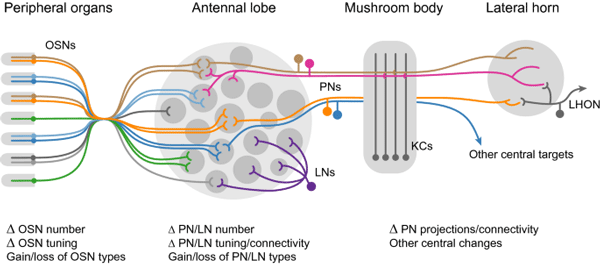Drosophila in Olfactory Research
The main functions of olfaction are related to finding food, avoiding predators, as well as social communication. Drosophila has been used as a model organism for more than 100 years and has a wealth of basic knowledge and research techniques. Here, we introduce some applications of Drosophila-based research on olfactory system and olfactory circuit development for our global clients.
Introduction of Drosophila Olfactory System
The olfactory nervous system of Drosophila is simpler than that of mammals, but has similar brain regions as human olfactory bulb and other higher constructs, which allows Drosophila to discriminate odor molecules in the environment in order to decide what to do like mammals. In addition, the basic neural circuits of Drosophila has been well characterized, which can be applied in other organisms.
The Drosophila genome has about 80 odorant receptor genes, and adults generate 50 neuron classes and over 1300 neurons. Drosophila adults have two main olfactory appendages, i.e., the antennae and the maxillary palps. The surfaces of both structures are covered with hair-like structures called sensilla. Each contains 1-4 olfactory sensory neurons (OSNs). Every OSN expresses only one tuning receptor that recognizes a particular or set of substances. When the odorant is recognized by a specific OSN, the signal is projected through the axon terminal of the projection neuron (PNs) into the mushroom body and lateral horn, then this information is sent to higher centers in the brain.
 Fig.1 Overview of the olfactory system in Drosophila (Zhao et al. 2020)
Fig.1 Overview of the olfactory system in Drosophila (Zhao et al. 2020)Drosophila Applications in Olfactory Systems Research
The main functions of olfaction are related to finding food, avoiding predators, as well as social communication. Although olfactory shares common features with visual and auditory cognition, there is a surprising diversity in olfactory system, both in mammals and in fruit flies. These differences can be used effectively not only to assess the prevalence of cognitive and consciousness models. Also, they can be used to explore the origins of neural diversity and its molecular mechanisms. In addition, many scientists have used the olfactory system of Drosophila as an excellent model of neurological development, for systematic observation of the growth and development of neural circuits. Finally, it has been found that the breakdown of the olfactory system may be associated with neurodegenerative diseases as well as other disorders (e.g. schizophrenia). In the future, it could be possible to control or delay nerve cell damage caused by neurodegenerative diseases via resolving the mechanisms of degeneration and death of olfactory neurons in the brain.
CD BioSciences has decades of experience in Drosophila neuroscience. We are able to provide comprehensive scientific services for auditory disease mechanisms and regeneration to clients worldwide. Please feel free to contact us for discussing your project and creating a custom quote.
References
- Laissue PP, et al. (2008). The olfactory sensory map in Drosophila. Brain development in Drosophila melanogaster, 102-114.
- Barish S, et al. (2015). Mechanisms of olfactory receptor neuron specification in Drosophila. Wiley Interdisciplinary Reviews: Developmental Biology, 4(6), 609-621.
- Liou NF, et al. (2018). Diverse populations of local interneurons integrate into the Drosophila adult olfactory circuit. Nature communications, 9(1), 1-13.
- Zhao Z, et al. (2020). Evolution of olfactory circuits in insects. Journal of Comparative Physiology A, 206(3), 353-367.
For research use only. Not intended for any clinical use.
Related Services
